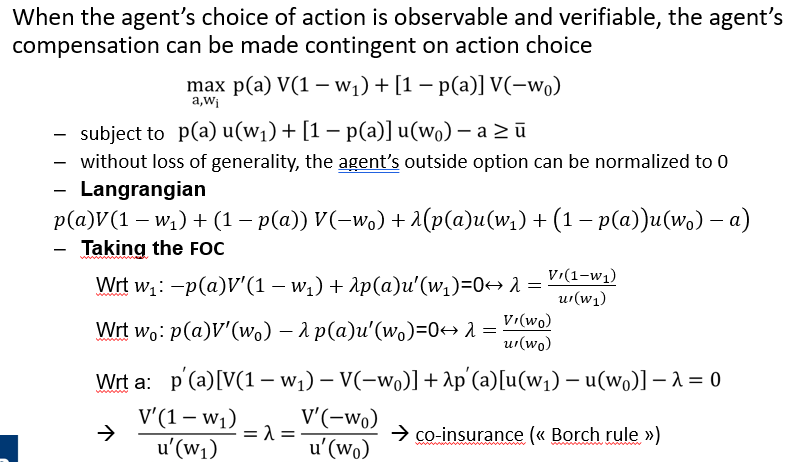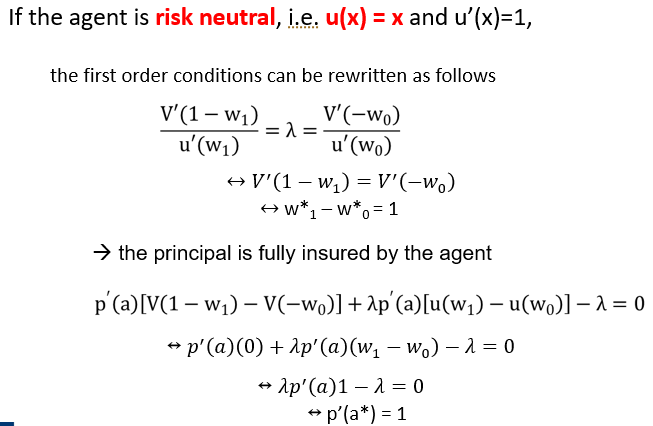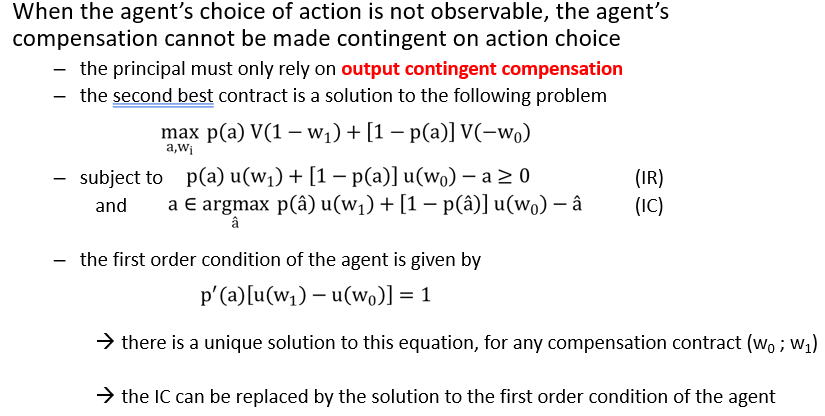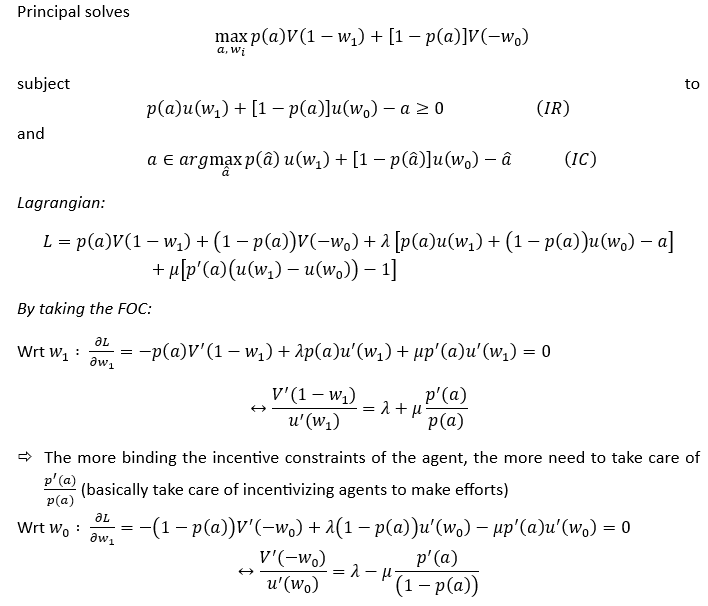Course 5 - Moral Hazard
1/17
There's no tags or description
Looks like no tags are added yet.
Name | Mastery | Learn | Test | Matching | Spaced |
|---|
No study sessions yet.
18 Terms
Principal-Agent Relationship - Moral Hazard
Principal hires agent to perform a task
Agent chooses an effort level a, which affects the output q
Effort = costly for agent, so principal must compensate to encourage them + output-Based Compensation BUT q ≠ perfect indicator
=> leading to some inefficiency
Observable actions
Agent’s effort = observable => principal can directly reward or penalize agent
=> Allows design of an incentive contract that aligns : agent’s actions with principal's goals
Co-Insurance (Borch Rule):
If principal & agent both share some risk, their optimal contract balances how much risk each party bears

Observable actions - Risk neutral prinicpal

Observable actions - Risk neutral agent

Unobservable Actions
Principal must rely solely on output-based compensation
=> introduces complications, as the agent’s actions cannot be directly tied to the rewards
Agent chooses their effort based on how they expect their actions to influence their compensation

Unobservable Actions - Risk Neutral Agent
Compensation scheme can be adjusted to incentivize the agent to exert a specific effort level

Unobservable Actions - Risk Neutral Principal
They = indifferent to risks of output variability, leading to simpler contracts where agent = fully insured

Unobservable Actions - Bilateral Risk Aversion
Both parties = risk-averse, designing optimal incentive contract = more complex
Principal must balance providing incentives with sharing risks, often leading to compensation structures that trade off between motivating effort & providing insurance to agent

Linear Contracts
Contract form: w = t + s ⋅ q
t: Fixed compensation (base salary).
s: Variable compensation (incentive).
q: Observed output or performance
Output equation: q = a + ϵ
a: Effort level chosen by the agent.
ϵ: Random shock, representing uncertainty in outcomes, with ϵ ∼ N(0,σ2)
Output = partly driven by the agent's effort (a) & partly by random factors (ϵ) that the agent cannot control.
Managerial Incentives
= designed to align interests of managers (like CEOs) with those of shareholders
Managerial Incentives - Shareholders vs. Managers
Shareholders (principal) want to :
Maximize the long-term value of the firm
Managers (agent) may have:
Personal goals like job security, minimizing effort, or maximizing their own short-term compensation
Since managers typically control day-to-day decisions, their interests may not always align with those of shareholders => Principal-Agent Problem
Managerial Incentives - Managerial remuneration package
Managerial compensation often includes 3 key components:
Fixed Salary ≠ vary with company's performance
Short-Term Incentives (Bonuses) = based on company's short-term performance
Long-Term Incentives (Stock Options) = incentivizing managers to increase the firm's value over time
Managerial Incentive - Theory vs. Practice
Theory:
Assume that firms offer managers "take-it-/-leave-it" compensation package
Practice:
Managerial Influence:
Managers often draws a compensation package & gets it approved
Rent Extraction:
When managers are able to secure higher compensation through their influence over pay-setting, it is described as rent extraction.
Managerial Incentives - Volatile Stock Prices impact on Compensation
Stock price =highly volatile, manager's compensation through stock options becomes more uncertain
To offset this risk, managers may demand a higher fixed salary or a larger share of profits as compensation for the increased risk
As a result, the proportion of their compensation tied directly to stock price movements might decrease.
Bertrand & Mullainathan (2001):
This study finds that CEO pay is often influenced by "luck," meaning that compensation can increase due to factors beyond the CEO's control (e.g., oil prices for oil companies)
This suggests that in firms with :
weaker governance = compensation may not be as tightly linked to performance
well-governed firms = pay-for-luck =lower, indicating that incentive schemes are more closely tied to actual performance
Gayle & Miller (2009)
This study examines how CEO compensation has evolved over time, noting that :
as firms have grown larger, the cost of aligning incentives between shareholders & managers has increased => leading to higher compensation.
Lazear (2000)
This paper looks at how changing compensation structures (from fixed salaries to performance pay) can significantly boost productivity
But it also highlights a downside:
workers may manipulate poorly designed performance metrics if they are rewarded based on them
Fehr & Falk (2002)
This study explores how financial incentives might crowd out intrinsic motivation, suggesting that :
too much emphasis on performance pay might lead to neglect of other valuable activities not directly tied to incentives